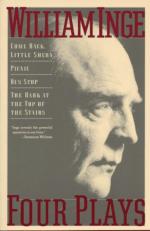|
This section contains 415 words (approx. 2 pages at 400 words per page) |

|
Come Back, Little Sheba Summary & Study Guide Description
Come Back, Little Sheba Summary & Study Guide includes comprehensive information and analysis to help you understand the book. This study guide contains the following sections:
This detailed literature summary also contains Bibliography and a Free Quiz on Come Back, Little Sheba by William Inge.
Come Back, Little Sheba was to become William Inge's most popular play But the Broadway production did not create an immediate "smash hit." In his foreword to Four Plays, published in 1958, Inge observes that the play was popular with only about half of its reviewers and that its Broadway run was less than six months Inge also reveals that he took a cut in royalties, and the cast took a cut in salary to keep the play running after the audiences dwindled within a few weeks of its opening. But in spite of the lukewarm reviews, Come Back, Little Sheba brought Inge several honors, including the George Jean Nathan Award and the Theatre Time Award.
At the time of its writing, Inge 's play focused on subjects that were still controversial and not often discussed in public. Sexuality and pregnancy out of wedlock were shocking topics not usually portrayed In drama. Lola's pregnancy, which forced a shotgun wedding, was the type of scandal that families went to great effort to hide This was also true of alcohol addiction. Membership in Alcoholics Anonymous was not a topic for casual conversation, and the kind of drunken scene Doc creates in Act II was a seventeen minute revelation for most audiences.
Many critics attacked Come Back, Little Sheba's use of symbolism, which they felt was too obvious. Most often Lola's dreams, Sheba the dog, and the blatant phallic symbolism of Turk's Javelin were singled out for such criticism. Other reviewers noted that the characters were either flat or too contrived--or boring and repetitive. But reviewers who praised the play often found that Inge 's drama did accurately portray the suffering of ordinary people. In spite of the mixed nature of the reviews, most critics dId agree on one topic, praising the performances of Shirley Booth as Lola, and Sidney Blackmer as Doc, which they felt transcended the material.
In the decades following Come Back, Little Sheba's debut, the general consensus has been laudatory toward Inge 's work. The play is now considered a groundbreaking achievement in the genre of domestic drama. While its subject matter has become common fodder fueling the mundane storylines of countless soap operas, Come Back, Little Sheba was among the first dramas to skillfully address the confluence of such topics as alcoholism, failed marriage, and broken dreams. While the play is sometimes referred to as dated and melodramatic, it is nevertheless valued as a prototype for realistic contemporary social theater.
Read more from the Study Guide
|
This section contains 415 words (approx. 2 pages at 400 words per page) |

|



